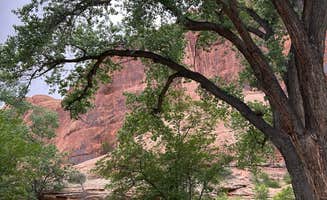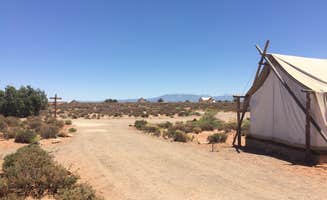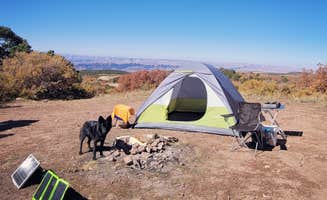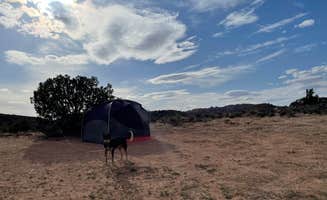Dispersed camping areas near Moab, Utah offer varied terrain at elevations between 4,000-5,000 feet. The red rock desert environment experiences temperature swings of 30-40°F between day and night, particularly during spring and fall camping seasons. Most primitive sites require portable waste systems as regulations prohibit digging catholes within Moab's fragile desert ecosystem.
What to do
Climbing access: 5-minute drive from Jaycee Park Campground to Wall Street, a popular climbing destination. "We stayed here two nights and my main complaints are that there is no water available so we had to fill up in town," notes Katie M., highlighting the need to prepare for activities.
Off-road exploration: 40+ trails available near the Behind the Rocks Road Dispersed area. A camper notes: "The road coming in is veryyy bumpy and rocky, but 2WD accessible with patience. For my first couple days, I camped almost exactly at the coordinates provided here. Not a bad spot, but I had tons of neighbors really close by."
Canyon hiking: Short walks available directly from Moonflower Canyon Group Site to ancient petroglyphs and natural features. "There is a very small box canyon at the end of the trail that is fun to spend a few minutes exploring," reports one visitor, adding easy access to the "ancient Indian ladder hidden in a crack in the sandstone wall."
What campers like
Vehicle-free tent spaces: Many appreciate the tranquility at Up the Creek Campground where parking remains separate. "You park in the lot and carry your gear (carts provided) to your site. Showers and dish washing area kept up very nicely twice a day. BBQs available to cook all set up and ready to go," explains Graham W.
Privacy variations: Some sites at Behind the Rocks offer better seclusion than others. "For the rest of the week, I moved to another spot a little closer to the entrance, and it was a lot more private. Really recommend this spot if you can snag it," suggests a camper who found the perfect balance between access and isolation.
Budget-friendly options: Free camping on BLM land often requires preparation. "We just needed a place to pull over for the night and get some truck bed sleep, it worked fine for us," says Jeff K. about Yellow Circle Road Dispersed Camping Area, acknowledging its functionality despite road noise.
What you should know
Road conditions vary significantly: High clearance vehicles provide better access to remote sites. "The higher up you go on the road, the rougher. We took our travel trailer (22' total) up, just have to be careful," reports Nathan L. about Yellow Circle Road, where maintained roads transition to rough terrain.
Vehicle suitability assessment: Consider your vehicle capabilities when selecting campsites. "Bumpy drive in 4x4 and high clearance definitely recommended. Probably 5/6 spots large enough for big groups," notes Anwyn P. about Gemini Bridges Campground.
Equipment transport requirements: Walk-in sites require carrying gear varying distances. "All gear will need to be walked in from the parking area. This is a minimum walk of 30 feet, but likely between 30-60 feet," explains a Moonflower Canyon camper, highlighting the logistics of setting up.
Tips for camping with families
Sand management strategies: Prepare for fine sand at some sites affecting comfort. "The entire area is deep sand. It's a great soft surface for sleeping on, but will add some challenges too. You will have sand in and throughout everything you own," advises a visitor to Moonflower Canyon.
Timing matters: Arrive early to secure limited prime spots. "We got there around noon on a Thursday and only found one open spot, got super lucky," reports a Gemini Bridges visitor, highlighting competition for the approximately six group-sized spots.
Event interference awareness: Check calendars for organized activities that might impact your stay. "They're kicking everyone out on Tuesday. They say that there are 1 or 2 persistent campers every year that they have to call the sheriff on," warns a Behind the Rocks camper about a scheduled ultra marathon.
Tips from RVers
Site selection by vehicle type: Larger rigs require specific site planning. "Flatter spaces, good for RVs, are farther back," notes Andria R. about Behind the Rocks camping areas, helping travelers identify suitable locations for various vehicle sizes.
Utility limitations: All dispersed sites lack hookups, requiring self-sufficiency. "No amenities, but Moab is nearby and has places to fill water, dump station, etc.," explains Alex P. about Yellow Circle Road, emphasizing resource planning for extended stays.
Cell service considerations: Signal varies dramatically by location. "Cell signal comes from the interstate north, so if you are higher up you may get cell signal," explains Greg L. about BLM Mineral Point Road Dispersed Camping, noting connectivity influences site selection for many travelers.













